What You Should Know
- How to play simple guitar chords
- How to switch between chords (recommended)
What You Will Learn
- How to play common seventh chords
Simple Seventh Chords for Guitar
A seventh chord adds one additional note to the major and minor chords you have learned previously. These chords will drastically increase the amount of music you can play. Many of these extended chords use fingerings similar to the chord you have already learned, which means you won't have to adjust more than one or two fingers to play the new chord.
The similarities mentioned here are only to help you see how the new chords relate to chords you learned previously. You should use these similarities as a starting point for learning the new chords, but don't rely on them after the first few times you play each chord. At that point, you need to see each chord as a unique chord without using the similarities with another chord as a crutch.
Dominant Seventh Chords
Dominant seventh chords are represented by the chord symbol 7. An example of this is G7, which is pronounced "G seven" or "G seventh."
G7 Chord
Chord Diagram

Tablature
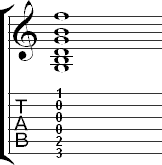
E7 Chord
Chord Diagram

Comments
E7 is similar to E major. Start with E major and simply lift your ring finger off of the fourth string to get E7.
Tablature
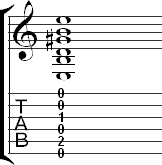
A7 Chord
Chord Diagram

Comments
A7 is easy if you use the fingering for A major from the lesson on first position chords. You only need to lift your index finger off of the third string so the string can be played open. The rest of the notes are the same. Avoid muting the first and third strings with the middle and ring fingers.
Tablature
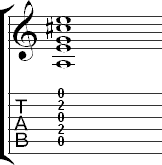
D7 Chord
Chord Diagram

Comments
Avoid muting the second string with your middle finger. Make sure that it is angled so that it can play the third string, while missing the second.
Tablature
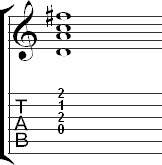
C7 Chord
Chord Diagram

Comments
Start with a C major chord and add the pinky on the third fret of the third string to get C7. This chord can be challenging since it uses all four fingers, so make sure you are relaxed. Don't mute the first string with the index finger.
Tablature
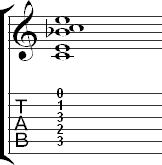
B7 Chord
Chord Diagram

Comments
B7 is a difficult chord for most beginners. It is the only chord in this lesson that doesn't relate to a chord you have learned in a previous lesson. The fingering is also somewhat awkward. You may want to wait until you have learned the other chords well before learning this one. Note the similarities between this and the D7 chord fingering. The index, middle, and ring fingers form the same shape in B7 and D7, although the fingers are placed on a different set of strings.
Tablature
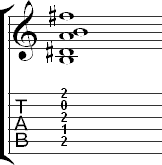
Major Seventh Chords
Major seventh chords use the chord symbol maj7. For example, Cmaj7. This is pronounced "C major seven" or "C major seventh."
Amaj7 Chord
Chord Diagram

Comments
Amaj7 (pronounced "A major seventh" or "A major seven") is another chord that is easy if you use fingering suggested for A major in a previous lesson. You only need to move your index finger back one fret to the first fret of the third string.
Tablature
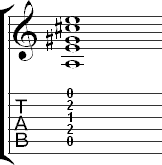
Cmaj7 Chord
Chord Diagram

Comments
Cmaj7 is just a C major chord with the index finger lifted so the second string is open.
Tablature
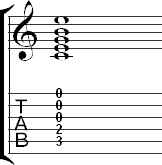
Minor Seventh Chords
The chord symbol for minor seventh chords is m7. An example is Am7. Pronounce this as "A minor seven" or "A minor seventh."
Am7 Chord
Chord Diagram

Comments
Am7 can be played by fretting A minor and lifting the ring finger off of the third string. The fingers are also used in the same way as in the E7 chord, but on a different group of strings. If you can play E7, Am7 should be easy.
Tablature
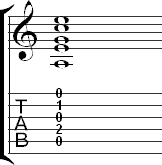
Em7 Chord
Chord Diagram

Comments
Learn Em7 by starting with an E minor chord. Next, add your pinky on the third fret of the second string. Make sure you aren't muting the first or third strings with your pinky or ring finger. If you have small hands, this fingering may be difficult due to the stretch involved. An alternate fingering is to use the index finger on the fifth string, the middle finger on the fourth string, and the pinky on the second string.
Tablature
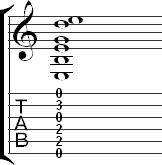
Dm7 Chord
Chord Diagram

Comments
Dm7 has three notes in common with the F major chord. It can be fingered by fingering an F major chord and lifting the ring finger off the fourth string so the string can be played open. Like F major, the chord has a bar on the first two strings with the index finger. If you can already play F major, this chord should be relatively easy.
Tablature
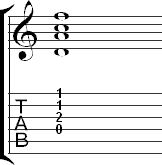

Comments
Note the similarities in shape between G7 and the C major and F major chords. The middle and ring fingers form a similar shape in all three chords. Pay attention to the shape of these fingers when moving between these chords.
Avoid muting the fourth string with the middle finger.